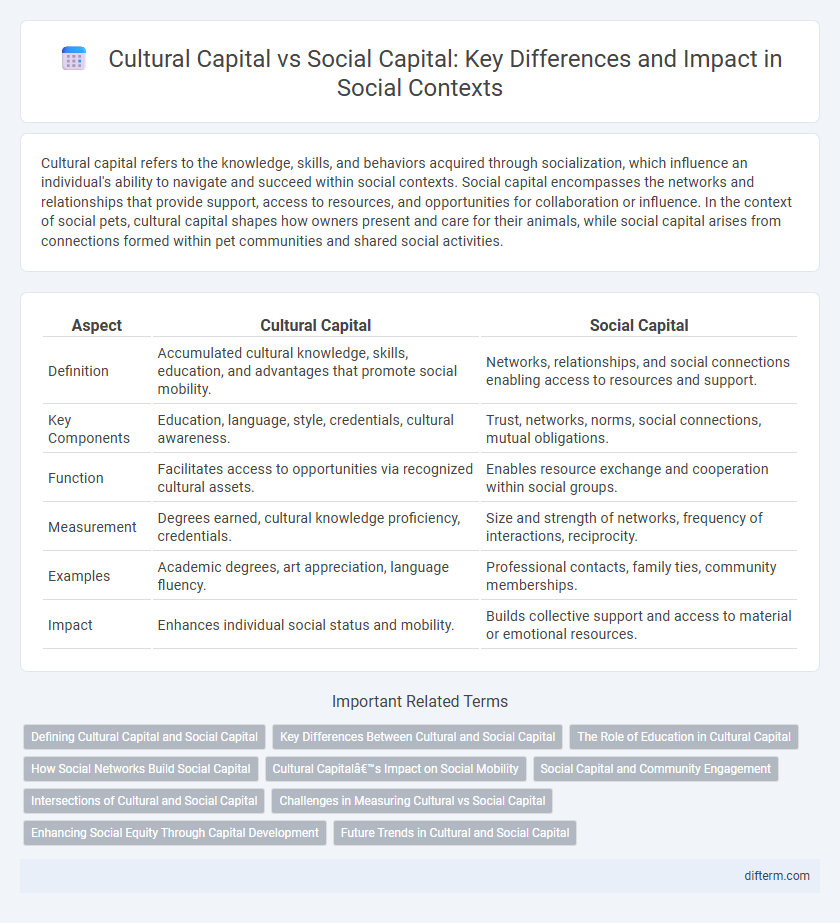Cultural capital refers to the knowledge, skills, and behaviors acquired through socialization, which influence an individual's ability to navigate and succeed within social contexts. Social capital encompasses the networks and relationships that provide support, access to resources, and opportunities for collaboration or influence. In the context of social pets, cultural capital shapes how owners present and care for their animals, while social capital arises from connections formed within pet communities and shared social activities.
Table of Comparison
| Aspect | Cultural Capital | Social Capital |
|---|---|---|
| Definition | Accumulated cultural knowledge, skills, education, and advantages that promote social mobility. | Networks, relationships, and social connections enabling access to resources and support. |
| Key Components | Education, language, style, credentials, cultural awareness. | Trust, networks, norms, social connections, mutual obligations. |
| Function | Facilitates access to opportunities via recognized cultural assets. | Enables resource exchange and cooperation within social groups. |
| Measurement | Degrees earned, cultural knowledge proficiency, credentials. | Size and strength of networks, frequency of interactions, reciprocity. |
| Examples | Academic degrees, art appreciation, language fluency. | Professional contacts, family ties, community memberships. |
| Impact | Enhances individual social status and mobility. | Builds collective support and access to material or emotional resources. |
Defining Cultural Capital and Social Capital
Cultural capital refers to the accumulation of knowledge, behaviors, and skills that one can use to demonstrate cultural competence and social status, including education, style of speech, and mannerisms. Social capital consists of the networks, relationships, and connections that enable individuals to access resources and support within a community or society. Both forms of capital influence social mobility and the ability to navigate social institutions effectively.
Key Differences Between Cultural and Social Capital
Cultural capital encompasses the knowledge, skills, education, and cultural competencies that individuals acquire, influencing their social mobility and access to resources. Social capital refers to the networks, relationships, and social connections that facilitate cooperation, trust, and the exchange of information within communities. Key differences lie in their nature: cultural capital is embodied in personal attributes and cultural knowledge, while social capital exists in the structure and quality of social networks.
The Role of Education in Cultural Capital
Education plays a critical role in building cultural capital by transmitting knowledge, values, and social norms that foster intellectual and aesthetic development. Schools and educational institutions provide access to cultural resources such as literature, art, and language skills that enhance social mobility and influence social interactions. This accumulation of cultural capital often complements social capital, improving individuals' ability to navigate and succeed within diverse social networks.
How Social Networks Build Social Capital
Social networks build social capital by facilitating trust, reciprocity, and access to resources among individuals and groups within a community. Strong ties in these networks enable the exchange of information, support, and opportunities that enhance collective well-being and social cohesion. This connectivity contrasts with cultural capital, which involves accumulated knowledge, skills, and cultural competencies, by emphasizing relational assets and communal interactions.
Cultural Capital’s Impact on Social Mobility
Cultural capital, encompassing education, skills, and cultural knowledge, plays a critical role in shaping social mobility by influencing access to opportunities and social networks. Individuals with high cultural capital often navigate educational systems and professional environments more effectively, leading to improved social and economic outcomes. This dynamic highlights the intertwined nature of cultural and social capital in advancing upward mobility within society.
Social Capital and Community Engagement
Social capital refers to the networks, relationships, and trust that facilitate cooperation and collective action within a community, enhancing social cohesion and mutual support. High social capital promotes community engagement through shared norms and reciprocal interactions, enabling resource exchange and collaborative problem-solving. Strengthening social capital leads to increased civic participation, improved well-being, and greater resilience in social groups.
Intersections of Cultural and Social Capital
Intersections of cultural and social capital reveal how shared cultural knowledge and social networks jointly enhance access to opportunities and resources. Cultural capital, including education, skills, and cultural tastes, amplifies the value of social capital by strengthening relationships within influential social groups. Together, these forms of capital shape social mobility and reinforce inequalities across diverse communities.
Challenges in Measuring Cultural vs Social Capital
Measuring cultural capital involves assessing intangible assets like education, skills, and cultural knowledge, which are difficult to quantify and vary widely across societies. Social capital measurement faces challenges in capturing the quality and strength of social networks, trust, and reciprocity within communities. Both types of capital require nuanced, context-specific indicators to accurately reflect their influence on social outcomes.
Enhancing Social Equity Through Capital Development
Cultural capital, encompassing education, skills, and cultural knowledge, and social capital, characterized by networks and social relationships, both play crucial roles in enhancing social equity. Developing these forms of capital enables marginalized communities to access resources, opportunities, and social mobility, effectively reducing systemic inequalities. Strategies that invest in cultural education and community-building initiatives drive sustainable social equity by empowering individuals and strengthening collective social bonds.
Future Trends in Cultural and Social Capital
Advancements in digital communication and globalization are reshaping the dynamics between cultural capital and social capital, with increased emphasis on online cultural participation and virtual networking. Future trends indicate a growing integration of diverse cultural competencies and expanded social networks across digital platforms, enhancing both individual social mobility and community resilience. Data-driven social capital models are expected to optimize cultural resource distribution, fostering inclusive social development in multicultural societies.
cultural capital vs social capital Infographic

 difterm.com
difterm.com